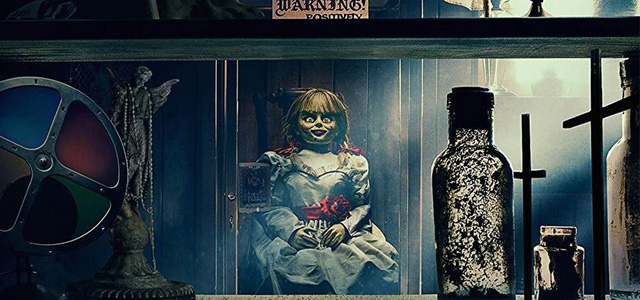Review: Annabelle
Comes Home
Starring McKenna Grace, Madison Iseman, Katie Sarife, Vera Farmiga, and Patrick
Wilson
Directed by Gary Dauberman
In the strange extended universe of The Conjuring, spin-off series Annabelle has somehow spawned its own trilogy before The Conjuring itself has. Annabelle (2014) told a forgettable tale about the evil doll set in 1967, ending with the Warrens taking possession of it, while Annabelle: Creation (2017) took us back to the doll’s evil origins in 1955. Annabelle Comes Home is set in 1968, after the Warrens got their hands on the doll, but still a few years before The Conjuring.
Your ability to place the film within the broader context of the series ultimately doesn’t matter – although Vera Farmiga and Patrick Wilson make an appearance and are excellent in their roles as Lorraine and Ed Warren, they’re only really in it at the beginning and end. Instead the film focuses on young daughter Judy Warren (Mckenna Grace) and her babysitter, Mary (Madison Iseman), who have to deal with Annabelle’s curse when Mary Ellen’s best friend, Daniela (Katie Sarife) lets the evil doll out of its sanctified lockbox home in the Warrens’ wonderful basement full of haunted objects.
Annabelle Comes Home is a fairly traditional horror film in many ways, but it’s also deceptively clever. Being this deep into a popular franchise allows the screenplay to use a certain shorthand mythology. You don’t need to have seen many, or possibly any, of the previous films in the series to understand the basic facts here – the Warrens are based on a real couple, they deal with ghosts and ghouls, and the movies take it as a given that religious symbology and incantations are essential in fighting against the dark forces at the heart of the franchise. Early on, we see a video of Ed performing an exorcism; the teenagers watching the video know better than to question its effectiveness, or to try and explain it away. In the Conjuring universe, exorcisms are important, and they work.
There’s something liberating about a horror film where the veracity of the haunting is never in doubt. There are no skeptics in the Conjuring universe, at least not once the chains start rattling – the Warrens might have been hucksters in real life, but the films take their claims at face value, and render a world in which the demon powers they claimed to have driven out are definite and real. The Warrens’ basement is blessed once a week, we’re told, and that’s really all the exposition we need about the doll locked away in the cabinet, even if you haven’t seen (or simply don’t remember) the previous two Annabelle films. It’s refreshing to have a supernatural horror movie in which characters never stop to try and explain what’s happening, because it’s very clear – the doll got out, the doll is evil, the doll must be stopped.
Mileage may vary on scares – there were certainly plenty of people jumping and yelling in the cinema I saw the film in, even if I wasn’t one of them – but more than anything Annabelle Comes Home evokes the feeling of being in a surprisingly well-designed carnival haunted house, one that prioritises creativity and flair over spring-loaded cats. This is a visually clever movie, one that builds up its tension through slow pans, long takes and smart use of deep focus.
The fun of the movie comes from its clear focus – this is, at its heart, a simple story about some likable kids dealing with a haunted house. The heavy lifting on why its haunted is explained in other movies, but Annabelle Comes Home is smart enough to know that it can afford a handwave, too – ‘the doll is evil, this movie’s world is full of evil, don’t overthink it’. In truth, the movie spills over into proper goofiness in places, but that’s not a huge problem – it plays further into the impression that the film is more like a good fairground ride than a standard narrative experience, a film built around jolts and laughs and moments where you think ‘oh, that’s cool’. And it’s able to achieve all of that because the franchise has done a good job of establishing firm ground rules and mythologies that are easy to parse regardless of your familiarity with the series.
Annabelle Comes Home doesn’t exactly present an in-depth exploration of its own spirituality, nor does it critique its own interpretation of the supernatural or the power of the religious forces that battle against evil in the film. It’s just about the best-case scenario for the sixth film in a horror franchise – silly, yes, and not exactly high art, but its focus on being fun and wild instead of trying to deepen the mythology is why it succeeds.
Annabelle Comes Home is now playing in cinemas
James O’Connor






